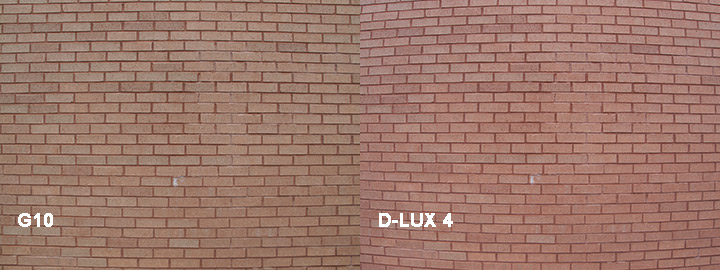The Canon G10 has an angle of view coverage corresponding to that of a 28-140mm zoom for the 35mm format, whereas the D-LUX 4/LX3 covers the same angle of view as a 24-60mm lens. As explained here, the D-LUX/LX3 manages to cover that diagonal angle of view in all three selectable aspect ratios (4:3, 3:2, 16:9).
Complicating things is the fact that the D-LUX 4/LX3 performs correction of barrel distortion during the in-camera conversion to JPEG. Thus, for wide angle photo files, part of the angle of view is discarded during conversion. As it turns out, the 24-60mm equivalent angle of view coverage corresponds to the diagonal angle of view coverage for the in-camera JPEG files. The RAW capture is significantly wider than 24mm equivalent.
In the following comparison, the upper left image shows the field of view (FOV) coverage for the G10 at its widest setting (28mm equivalent) and native aspect ratio (4:3). This is the entire frame after resizing. The remainder of the top row shows the in-camera JPEG FOV coverage for the D-LUX 4 at its widest setting (24mm equivalent) in 4:3, 3:2, and 16:9 aspect ratios, from left to right. Underneath each of the D-LUX 4 frames, you can see the FOV captured in the corresponding RAW image.
Of note, the extended FOV available in D-LUX 4/LX3 RAW is only accessible in certain software such as Raw Developer or Raw Photo Processor. Silkypix, Capture One, and all Adobe Raw products automatically correct barrel distortion and therefore do not allow one to preserve the wider FOV.
A similar comparison of the two cameras at the telephoto end of their respective zoom ranges doesn't show much difference between RAW and JPEG for the D-LUX 4:
The Canon G10 lens has relatively mild barrel distortion compared to the uncorrected D-LUX 4 lens at 28mm equivalent:

In Part 3, we'll look at the dynamic range of these two cameras compared to the Sigma DP1 in a real world application.



